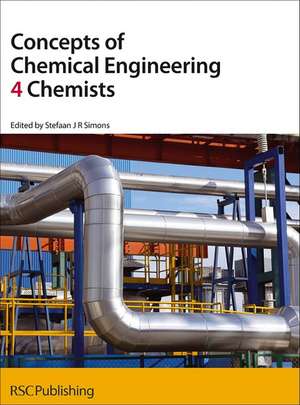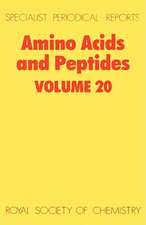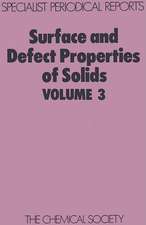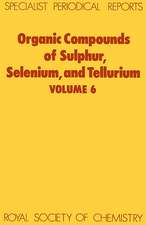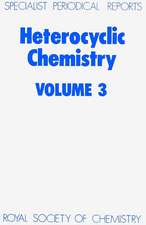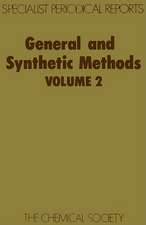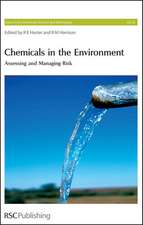Concepts of Chemical Engineering 4 Chemists: Rsc
Autor Royal Society of Chemistry E. Sorensen Editat de Stefaan J. R. Simonsen Limba Engleză Hardback – 28 feb 2007
Based on the popular course of the same title, Concepts of Chemical Engineering 4 Chemists outlines the basic aspects of chemical engineering for chemistry professionals. It clarifies the terminology used and explains the systems methodology approach to process design and operation for chemists with limited chemical engineering knowledge. The book provides practical insights into all areas of chemical engineering, including such aspects as pump design and the measurement of key process variables. The calculation of design parameters, such as heat and mass transfer coefficients, and reaction scale-up are also discussed, as well as hazard analysis, project economics and process control. Designed as a reference guide, it is fully illustrated and includes worked examples as well as extensive reference and bibliography sections. Concepts of Chemical Engineering 4 Chemists is ideal for those who either work alongside chemical engineers or who are embarking on chemical engineering-type projects.
Preț: 387.84 lei
Nou
Puncte Express: 582
Preț estimativ în valută:
74.24€ • 80.66$ • 62.40£
74.24€ • 80.66$ • 62.40£
Carte tipărită la comandă
Livrare economică 21 aprilie-05 mai
Preluare comenzi: 021 569.72.76
Specificații
ISBN-13: 9780854049516
ISBN-10: 0854049517
Pagini: 370
Ilustrații: 1
Dimensiuni: 162 x 242 x 26 mm
Greutate: 0.74 kg
Ediția:1
Editura: Royal Society Of Chemistry
ISBN-10: 0854049517
Pagini: 370
Ilustrații: 1
Dimensiuni: 162 x 242 x 26 mm
Greutate: 0.74 kg
Ediția:1
Editura: Royal Society Of Chemistry
Cuprins
Chapter 1: Process Analysis - The Importance of Mass and Energy Balances; 1.1: Introduction 1; 1.1.1: Nomenclature and Units of Measurement 1; 1.2: Mass Balances 3; 1.2.1: Process Analysis Procedure 4; 1.2.2: Example 1: Mass Balance on a Continuous; Distillation Process; 1.2.3: Example 2: Mass Balance on a Process with Reaction; 1.3: Energy Balances; 1.3.1: Example 3: Energy Balance on a Distillation Column; 1.4: Summary; Recommended Reading; Chapter 2: Introduction to Chemical Reaction Engineering; 2.1: Introduction; 2.1.1: Classification of Reactors; 2.2: Chemical Reaction Kinetics; 2.2.1: Definitions; 2.2.2: Chemical Reaction Thermodynamics; 2.2.3 Kinetics; 2.2.4: Importance of Mass and Heat Transfer Processes; 2.2.5: Kinetics of a Catalytic Reaction; 2.3: Concepts of Chemical Reactor Design; 2.3.1: Mole Balances for Chemical Reaction; 2.3.2: Reactor Design Equation; 2.3.3: Comparison between Continuous Stirred Tank;Reactor and Plug Flow Reactor; 2.3.4: Recycle Reactor; 2.3.5: CSTRs in Series; 2.3.6: Multiple Reactions; 2.3.7: PFR with Continuous Uniform Feed of Reactant along the Whole Reactor; Recommended Reading; Chapter 3: Concepts of Fluid Flow; 3.1: Introduction; 3.2: Dimensionless Groups; 3.2.1: Example: Pipe Flow; 3.3: Viscosity; 3.3.1 Newton's Law of Viscosity; 3.3.2: Dynamic and Kinematic Viscosity; 3.3.3: Typical Values of Viscosity; 3.4: Laminar and Turbulent Flow; 3.4.1: Boundary Layers; 3.5: Balance or Conservation Equations; 3.5.1: General Form of the Conservation Equations; 3.5.2: Control Volumes; 3.5.3: Continuity Equation (Mass Balance); 3.5.4: Steady-State Momentum (Force) Balance Equation; 3.5.5: Steady-State Energy Balances; 3.5.6: Example of use of the Conservation Equations; 3.6: Pipe Flow; 3.6.1: Friction Factors; 3.6.2: Losses in Fittings 70; 3.6.3: Economic Velocities; 3.7: Flow Measurement; 3.7.1: Variable Head Meters; 3.7.2: Variable Area Meters; 3.7.3: Some Other Flowmeters; 3.8: Pumps and Pumping; 3.8.1: Positive Displacement Pumps; 3.8.2: Non-Positive Displacement Pumps; 3.8.3: Matching Centrifugal Pumps to Flow Requirements; 3.8.4: Pump Power Requirements; 3.9: Other Flows; 3.9.1: Equivalent Hydraulic Diameter; 3.9.2: Flow Around Bodies; 3.9.3: Stirred Tanks; 3.10: Example Calculations for the Pipe-Flow System; 3.10.1: Data; 3.10.2: Friction Losses; 3.10.3: Orifice Meter; 3.10.4: Pump Shaft Work; 3.10.5: System Head; 3.10.6: Pump Characteristics; 3.10.7: Control Valve; 3.10.8: Net Positive Suction Head; Nomenclature; References; Chapter 4: An Introduction to Heat Transfer; 4.1: Introduction and Objectives ; 4.1.1: Modes of Heat Transfer; 4.1.2: Scope and Objectives; 4.2: Modes of Heat Transfer: 4.2.1: Conduction; 4.2.2: Convection; 4.2.3: Radiation; 4.3: The Overall Heat Transfer Coefficient, U; 4.3.1: Example Calculation of U; 4.3.2: Overall Heat Transfer Coefficients with Curvature, for Example, Transfer through a Pipe Wall; 4.3.3: Overall Heat Transfer Coefficients with Convection and Radiation; 4.4: Transient Heat Transfer; 4.4.1: Example Calculation, Small Bi Case: Cooling of a Copper Sphere in Air; 4.4.2: Example Calculation, Large Bi Case: Cooling of a Perspex Plate in Water; 4.5: Heat Exchangers; 4.5.1: Double Pipe Heat Exchanger; 4.5.2: Heat Transfer in Heat Exchangers; 4.5.3: Performance of Heat Exchangers - Fouling; 4.5.4: Types of Heat Exchangers; 4.5.5: Numerical Examples; 4.6: Conclusions; Nomenclature; References; Chapter 5: An Introduction to Mass-Transfer Operations; 5.1: Introduction; 5.2: Mechanisms of Separation; 5.3: General Separation Techniques; 5.3.1: Separation by Phase Addition or Phase Creation; 5.3.2: Separation by Barrier; 5.3.3: Separation by Solid Agent; 5.4: Mass Transfer Calculations; 5.4.1: Equilibrium-Stage Processes; 5.4.2: Stage Calculations; 5.4.3: Graphical Methods; 5.4.4: Diffusional Rate Processes; 5.4.5: Diffusion Calculations; 5.5: Separation by Distillation; 5.5.1: Trays and Packing; 5.5.2: Design Range; 5.5.3: Operating Range; 5.5.4: Design Calculations; 5.5.5: Distillation Column Height; 5.6: Separation by Absorption; 5.6.1: Design Range; 5.6.2: Operating Range; 5.6.3: Design Calculations; 5.6.4: Amount of Solvent; 5.6.5: Absorption Column Height; 5.7: Further Reading; 5.8: Relevant Material not Considered in this Chapter; 5.8.1: Combined Reaction and Separation; 5.8.2: Combined Separation Units; 5.8.3: Batch Operation; References; Chapter 6: Scale-Up in Chemical Engineering; 6.1: Introduction and Objectives; 6.2: Units and Fundamental Dimensions; 6.3: Physical Similarity; 6.3.1: Geometric Similarity; 6.3.2: Dynamic Similarity; 6.3.3: Dimensionless Groups; 6.4: Dimensional Homogeneity; 6.5: Dimensional Analysis and Dimensionless Groups; 6.5.1: Example: Dimensional Analysis; 6.6: Buckingham Pi Theorem and Method; 6.6.1: Buckingham Pi Theorem; 6.6.2: Buckingham's Method - Procedure; 6.6.3: Example: Drag Force on a Sphere; 6.7: Use of Dimensionless Groups in Scale-Up; 6.7.1: Drag Force on a Particle; 6.7.2: Pressure Droooooop in a Pipe; 6.7.3: Modelling Flow Around a Body Immersed in a Fluid; 6.7.4: Heat Transfer; 6.7.5: Mass Transfer; 6.7.6: Correlation of ExperimentalData - Formation of Gas Bubbles at an Orifice; 6.7.7: Application of Scale-Up in Stirred Vessels; 6.7.8: Incompatibility of Some Equations; 6.8: Conclusions; Nomenclature; References
Recenzii
Easy to follow and contains many well explained worked examples......presentation of familiar concepts, like kinetics and thermodynamics, from a different angle is an ideal way to start learning some engineering terminology. Working through the excellent examples, the chemist reader should gain sufficient knowledge of a wide range of topics to apply many simple engineering principles.
Notă biografică
The Author Professor Simons is a Chartered Engineer and Fellow of the Institution of Chemical Engineers (IChemE) and is a member of the Executive Committee of the Standing Conference of Chemical Engineering Professors. He is also vice-chair of the committee of the IChemE's Particle Technology Subject Group and serves on the committee of the Royal Society of Chemistry's Process Technology Group, which initiated the short course on which this book is based. Professor Simons' expertise lies in particle technology, in general, and, more specifically, in the development of low carbon technologies in regards to the reduction of carbon dioxide emissions, particularly in carbon capture and storage, for which he was an expert reviewer of the Intergovernmental Panel on Climate Change's special report on this subject.
Textul de pe ultima copertă
Based on the popular course of the same title, Concepts of Chemical Engineering 4 Chemists outlines the basic aspects of chemical engineering for chemistry professionals. It clarifies the terminology used and explains the systems methodology approach to process design and operation for chemists with limited chemical engineering knowledge. The book provides practical insights into all areas of chemical engineering, including such aspects as pump design and the measurement of key process variables. The calculation of design parameters, such as heat and mass transfer coefficients, and reaction scale-up are also discussed, as well as hazard analysis, project economics and process control. Designed as a reference guide, it is fully illustrated and includes worked examples as well as extensive reference and bibliography sections. Concepts of Chemical Engineering 4 Chemists is ideal for those who either work alongside chemical engineers or who are embarking on chemical engineering-type projects.
Descriere
Designed as a reference guide, this book is fully illustrated with worked examples, extensive reference and bibliography sections.
